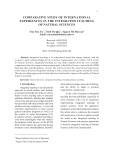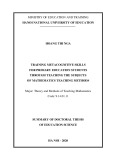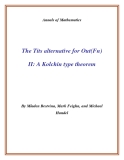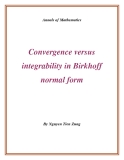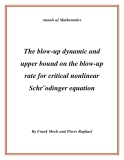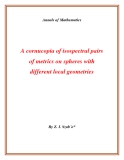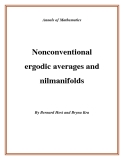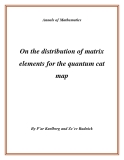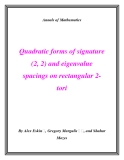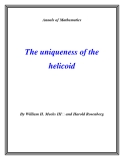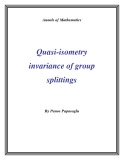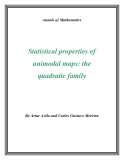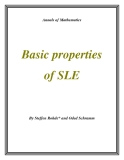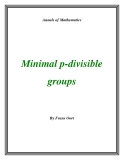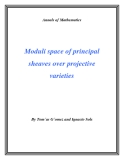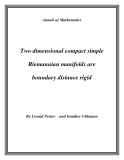Annals of Mathematics
Serre’s conjecture over
F9
By Jordan S. Ellenberg
Annals of Mathematics, 161 (2005), 1111–1142
Serre’s conjecture over F9
By Jordan S. Ellenberg*
Abstract
In this paper we show that an odd Galois representation ¯ρ : Gal( ¯Q/Q) → GL2(F9) having nonsolvable image and satisfying certain local conditions at 3 and 5 is modular. Our main tools are ideas of Taylor [21] and Khare [10], which reduce the problem to that of exhibiting points on a Hilbert modular surface which are defined over a solvable extension of Q, and which satisfy certain reduction properties. As a corollary, we show that Hilbert-Blumenthal abelian surfaces with ordinary reduction at 3 and 5 are modular.
Introduction
In 1986, J-P. Serre proposed the following conjecture [16]:
Conjecture. Let F be a finite field of characteristic p, and
¯ρ : Gal( ¯Q/Q) → GL2(F)
an absolutely irreducible representation such that det ¯ρ applied to complex con- jugation yields −1. Then ¯ρ is the mod p representation attached to a modular form on GL2(Q).
*Partially supported by NSA Young Investigator Grant MDA905-02-1-0097 and NSF
Grant DMS-0401616.
Serre’s conjecture, if true, would provide the first serious glimpse into the nonabelian structure of Gal( ¯Q/Q). The work of Langlands and Tunnell shows that Serre’s conjecture is true when GL2(F) is solvable; that is, when F is F2 or F3. Work of Shepherd-Barron and Taylor [17] and Taylor [21] have shown that the conjecture is also true, under some local and global conditions on ¯ρ, when F is F4 or F5; the work of Breuil, Conrad, Diamond, and Taylor [2] proves the conjecture when F is F5 and det ¯ρ is cyclotomic. More recently, Manoharmayum [12] has proved Serre’s conjecture when F = F7, again subject
JORDAN S. ELLENBERG
1112
to local conditions. His argument, like ours, uses the ideas of [21] and [10], together with a construction of solvable points on a certain modular variety.
In the present work, we show that Serre’s conjecture is true, again subject to certain local and global conditions, when F = F9. To be precise, we prove the following theorem.
Theorem. Let
¯ρ : Gal( ¯Q/Q) → GL2(F9)
be an odd Galois representation such that
• ¯ρ has nonsolvable image;
• The restriction of ¯ρ to D3 can be written as (cid:3) (cid:2)
, ∼ = ¯ρ|D3 ∗ ψ1 0 ψ2
where ψ1|I3 is the mod 3 cyclotomic character, and ψ2 is unramified;
• The image of the inertia group I5 lies in SL2(F9), and has odd order.
Then ¯ρ is modular.
As a corollary, we get the following result towards a generalized Shimura- Taniyama-Weil conjecture for Hilbert-Blumenthal abelian surfaces:
Corollary. Let A/Q be a Hilbert-Blumenthal abelian surface which has good ordinary or multiplicative reduction at 3 and 5. Then A is a quotient of J0(N ) for some integer N .
The corresponding theorem when A is an elliptic curve has now been proved without any hypotheses, thanks to the results of [24], [20], and [2]. The case where A is a Hilbert-Blumenthal abelian variety with real multiplication by a field with an ideal of norm 5 is treated in [17]. Our method follows theirs; one starts with a case of Serre’s conjecture that one knows, and uses lifting theorems to prove modularity of a Hilbert-Blumenthal abelian variety.
We prove the theorem above by exhibiting ¯ρ as the Galois representation on the 3-torsion subscheme of a certain Hilbert-Blumenthal abelian surface defined over a totally real extension F/Q with solvable Galois group. We then use an idea of Taylor, together with a theorem of Skinner and Wiles [19], to prove the modularity of the abelian surface, and consequently of ¯ρ.
The key algebro-geometric point is that a certain twisted Hilbert modular variety has many points defined over solvable extensions of Q. This suggests that we consider the class of varieties X such that, if K is a number field, and
SERRE’S CONJECTURE OVER F9
1113
L∈Σ
Σ is the set of all solvable Galois extensions L/K, then (cid:4) X(L)
is Zariski-dense in X. We say X has “property S” in this case. Certainly if X has a Zariski-dense set of points over a single number field—for example, if X is unirational—it has property S. The Hilbert modular surfaces we consider, on the other hand, are varieties of general type with property S.
To indicate our lack of knowledge about solvable points on varieties, note that at present there does not exist a variety which we can prove does not have property S! Nonetheless, it seems reasonable to guess that “sufficiently complicated” varieties do not have property S.
One might consider the present result evidence for the truth of Serre’s conjecture. On the other hand, it should be pointed out that the theorems here and in [17], [21] rely crucially on the facts that
• the GL2 of small finite fields is solvable, and
• certain Hilbert modular varieties for number fields of small discriminant have property S.
These happy circumstances may not persist very far.
In particular, it is reasonable to guess that only finitely many Hilbert modular varieties have property S. If so, one might say that we have much philosophical but little numerical evidence for the truth of Serre’s conjecture in general. Our ability to compute has progressed mightily since Serre’s conjecture was first announced. It would be interesting, given the present status of the conjecture, to carry out numerical experiments for F a “reasonably large” finite field—whatever that might mean.
The author gratefully acknowledges several helpful conversations with Brian Conrad, Eyal Goren, and Richard Taylor, and the careful reading and suggestions of the referee.
Added in Proof. Since the original submission of this paper, substantial progress has been made towards a resolution of Serre’s conjecture. The recently announced work of Khare and Khare-Wintenberger proves Serre’s conjecture in level 1 for an arbitrary coefficient field; this result, unlike ours, avoids the use of special geometric properties of low-degree Hilbert modular varieties, and thus presents a very promising direction for further progress. Recent work of Kisin generalizes the results we cite on lifting of modularity to handle many potentially supersingular cases; it seems likely that his methods could substantially simplify the argument of the present paper, by eliminating the necessity of showing that the abelian varieties we construct in Section 2 have ordinary reduction in characteristics 3 and 5.
JORDAN S. ELLENBERG
1114
Notation. If v is a prime of a number field F , we write GF for the absolute Galois group of F and Dv ⊂ GF for the decomposition group associated to v, and Iv for the corresponding inertia group. The p-adic cyclotomic character of Galois is denoted by χp, and its mod p reduction by ¯χp. If V ⊂ PN is a projective variety, write F1(V ) for the Fano variety of lines contained in V . If O is a ring, an O-module scheme is an O-module in the category of schemes.
All Hilbert modular forms are understood to have all weights equal. We denote by ω a primitive cube root of unity.
1. Realizations of Galois representations on HBAV’s
Recall that a Hilbert-Blumenthal abelian variety (HBAV) over a number field is an abelian d-fold endowed with an injection O (cid:6)→ End(A), where O is the ring of integers of a totally real number field of degree d over Q. Many Hilbert-Blumenthal abelian varieties can be shown to be modular; for example, see [17]. It is therefore sometimes possible to show that a certain mod p Galois representation ¯ρ is modular by realizing it on the p-torsion subscheme of some HBAV.
We will show that, given a Galois representation ¯ρ : Gal( ¯K/K) → GL2(F9) satisfying some local conditions at 3, 5 and ∞, we can find ¯ρ in the 3-torsion of an abelian surface over a solvable extension of K, satisfying some local con- ditions at 3 and 5. One of these conditions—that certain representations be “Dp-distinguished”—requires further comment.
Definition 1.1. Let ¯ρ : Gal( ¯K/K) → GL2(¯Fp) be a Galois representa- tion, and let p|p be a prime of K. We say that ¯ρ is Dp-distinguished if the semisimplification of the restriction ¯ρ|Dp is isomorphic to θ1 ⊕ θ2, with θ1 and θ2 distinct characters from Dp to ¯F∗ p.
This condition is useful in deformation theory, and is required, in partic- ular, in the main theorem of [19]. A natural source of Dp-distinguished Galois representations is provided by abelian varieties with ordinary reduction at p.
Proposition 1.2. Let p be an odd prime. Let Kv be a finite extension of Qp with odd ramification degree, and let A/Kv be a principally polarized HBAV with good ordinary or multiplicative reduction and real multiplication by O, and let p be a prime of O dividing p. Then the semisimplification of the Gal( ¯Kv/Kv)-module A[p] is isomorphic to θ1 ⊕ θ2, with θ1 and θ2 distinct characters of Gal( ¯Kv/Kv).
SERRE’S CONJECTURE OVER F9
1115
Proof. If A has multiplicative reduction, the theory of the Tate abelian variety yields an exact sequence
0 → (μp)g → A[p] → (Z/pZ)g → 0
over some unramified extension of Kv. If, on the other hand, A has good ordinary reduction, then A extends to an abelian scheme A over the ring of integers Rv of Kv. The finite flat group scheme A[p]/Rv then fits into the connected-´etale exact sequence
0 → A[p]0 → A[p] → A[p]et → 0
and we denote by A[p]0/Kv and A[p]et/Kv the generic fibers of the corre- sponding group schemes over Rv. Note that A[p]et is unramified as a Galois representation, and has dimension g.
So in either case A[p] has an unramified g-dimensional quotient A(cid:4)(cid:4). The ∼ Weil pairing yields an isomorphism of group schemes A[p] = Hom(A[p], μp); the unramified quotient A(cid:4)(cid:4) thus gives rise to a g-dimensional submodule of A[p] on which Iv acts cyclotomically.
(cid:4)(cid:4) → 0
Since the ramification degree of Kv/Qp is odd, the cyclotomic character of Iv is nontrivial. It follows that A[p] fits into an exact sequence of Galois representations
0 → A
(cid:4) → A[p] → A in which A(cid:4)(cid:4) is the Iv-coinvariant quotient of A[p], and dim A(cid:4) = dim A(cid:4)(cid:4) = g. Since the endomorphisms in O are defined over Kv, they respect this quotient; we conclude that the above exact sequence can be interpreted as a sequence of O-modules. We know by [15, 2.2.1] that A[p] is a two-dimensional vector space over O/p. Since the action of O is compatible with Weil pairing, we have ∧2A[p] O/p as O-modules. In particular, inertia acts cyclotomically on ∧2A[p], which means that A[p] ∩ A(cid:4) must have dimension 1 over O/p. We conclude that A[p] fits into an exact sequence of O-modules
∼ = μp ⊗Fp
(cid:4) → A[p] → B → 0
0 → A[p] ∩ A
which shows that the semisimplification of A[p] is indeed isomorphic to the sum of two characters θ1 and θ2. Since θ1|Iv is cyclotomic and θ2|Iv is trivial, the two characters are distinct.
We are now ready to state the main theorem of this section.
Proposition 1.3. Let K be a totally real number field, and let
¯ρ : Gal( ¯K/K) → GL2(F9)
be a Galois representation such that det ¯ρ = ¯χ3. Suppose that
JORDAN S. ELLENBERG
1116
• The absolute ramification degree of K is odd at every prime of K above 3 and 5.
• For any prime w of K over 3, the restriction of ¯ρ to the decomposition group Dw is (cid:3) (cid:2)
. ∼ = ¯ρ|Dw ¯χ3 ∗ 1 0
√
• The image of the inertia group Iv in GL2(F9) has odd order for every prime v of K over 5.
5], such that
Then there exists a totally real number field F with F/K a solvable Galois extension, and a Hilbert-Blumenthal abelian variety A/F with real multiplica- tion by O = OQ[
• The absolute ramification degree of F is odd at every prime of F over 3 and 5;
√
• A has multiplicative reduction at all primes of F above 3, and good ordi- nary or multiplicative reduction at all primes of F above 5; √ • The mod
5 : Gal( ¯F /F ) → GL2(F5)
5 representation ¯ρA, is surjective;
ι : A[3] • There exists a symplectic isomorphism of Gal( ¯F /F )-modules ∼ = ¯ρ| Gal( ¯F /F ).
√
2. Proof of Proposition 1.3
In order to produce Hilbert-Blumenthal abelian varieties, we will produce rational points on certain moduli spaces. Our main tool is an explicit de- scription of the complex moduli space of HBAV’s with real multiplication by O = OQ[ 5] and full 3-level structure, worked out by Hirzebruch and van der Geer. For the rest of this paper, an HBAV over a base S will be understood to mean a triple (A, m, λ), where
• A/S is an abelian surface;
• m : O (cid:6)→ End(A) is an injection such that Lie(A/S) is, locally on S, a free O ⊗Z OS module (the Rapoport condition);
• λ is a principal polarization.
See [14] for basic properties of this definition.
SERRE’S CONJECTURE OVER F9
1117
2.1. Twisted Hilbert modular varieties. We first describe some twisted versions of the moduli space of HBAV’s with full level 3 structure.
Suppose ¯ρ : Gal( ¯Q/Q) → GL2(F9) is a Galois representation with cyclo- tomic determinant. Let N be the product of the ramified primes of ¯ρ. We also denote by ¯ρ the O-module scheme over Z[1/N ] associated to the Galois representation. Choose for all time an isomorphism η : ∧2 ¯ρ
∼ = μ3 ⊗Z O. Now suppose A is an HBAV with real multiplication by O over a scheme T , and suppose A ∼ = ¯ρ. Then Weil pairing gives an is endowed with an isomorphism φ : A[3] ∼ isomorphism ∧2A[3] = μ3 ⊗Z O. Now composing ∧2φ with Weil pairing and with η yields an automorphism of μ3⊗Z O. If this automorphism is the identity, we say φ has determinant 1. If this automorphism is obtained by tensoring an automorphism of μ3 with O, we say φ has integral determinant. We define functors ˜F ¯ρ and F ¯ρ from Sch/Z[1/N ] to Sets as follows:
˜F ¯ρ(T ) = isomorphism classes of pairs (A, φ), where A/T is a prin- cipally polarized Hilbert-Blumenthal abelian variety with RM by O ∼→ ¯ρ is an isomorphism of O-module schemes over T , and φ : A[3] with integral determinant.
and
F ¯ρ(T ) = isomorphism classes of pairs (A, φ), where A/T is a prin- cipally polarized Hilbert-Blumenthal abelian variety with RM by O ∼→ ¯ρ is an isomorphism of O-module schemes over T , and φ : A[3] with determinant 1.
Proposition 2.1. The functor ˜F ¯ρ is represented by a smooth scheme ˜X ¯ρ over Spec Z[1/N ]. The functor F ¯ρ is represented by a smooth geometrically connected scheme X ¯ρ over Spec Z[1/N ].
Spec Z[1/N ]
Proof. We begin by observing that ˜F ¯ρ is an ´etale sheaf on Sch/Z[1/N ]. This follows exactly as in [4, Th. 2]; the key points are, first, that level 3 structure on HBAV’s is rigid, and, second, that HBAV’s are projective varieties and thus have effective descent.
For the first statement of the proposition, it now suffices to show that ˜F ¯ρ × OL[1/N ] is represented by a scheme, where L is a finite exten- Spec Z[1/N ] sion of Q unramified away from N . In particular, we may take L to be the fixed field of ker ¯ρ. Then ˜F ¯ρ × OL[1/N ] is isomorphic to the functor ˜F parametrizing principally polarized HBAV’s A together with isomorphisms ∼ = (O/3O)2 with integral determinant. This functor is representable by a A[3] smooth quasi-projective scheme ˜X over Spec Z[1/3] (cf. [14, Th. 1.22], [3, Th. 4.3.ix]).
JORDAN S. ELLENBERG
1118
Now the functor ˜F ¯ρ admits a map to Aut(μ3)
∼ = (Z/3Z)∗, by the rule (A, φ) (cid:12)→ (η ◦ ∧2φ). It is clear that F ¯ρ is the preimage under this map of 1 ∈ (Z/3Z)∗. By changing base to L and invoking Theorem 1.28 ii) and the discussion below Theorem 1.22 in [14], we see that X ¯ρ is geometrically connected.
L simply as X. The group PSL2(F9) acts on X by means of its action on (O/3O)2. (Note that (A, φ) and (A, −φ) are identified in X.) One can define exactly as in [14, §6.3] a line bundle ω on X ¯ρ which is invariant under the action of PSL2(F9).
We will sometimes refer to X ¯ρ
When R is a ring containing OL[1/N ], the sections of ω⊗k on XR are called Hilbert modular forms of weight k and level 3 over R; the space of Hilbert modular forms over C is in natural isomorphism with the analytically defined space of Hilbert modular forms of the same weight and level [14, Lemma 6.12]. Within the space H 0(X ¯Q, ω⊗2) of weight 2 modular forms of level 3 over ¯Q there is a 5-dimensional space of cuspforms, which we call C. The automor- phism group PSL2(F9) acts on C through one of its irreducible 5-dimensional representations. It is shown by Hirzebruch and van der Geer that this space of modular forms provides a birational embedding of X into P5. To be precise: fix for all time an isomorphism PSL2(F9) ∼ = A6 such that
• A6 acts on C through the 5-dimensional quotient of its permutation rep-
resentation; (cid:3) (cid:2)
• is sent to the double flip (01)(23). −1 0 1 0
• The subgroup of upper triangular unipotent matrices is sent to the group generated by (014) and (235).
Let s0 be a generator of the 1-dimensional subspace of C fixed by the stabilizer of a letter in A6, and let s0, . . . , s5 be the A6-orbit of s0. Note that s0 + · · · + s5 = 0.
Proposition 2.2. Let SZ be the surface in P5/Z defined by the equations
σ1(s0, . . . , s5) = σ2(s0, . . . , s5) = σ4(s0, . . . , s5) = 0,
C given by [s0 : s1 : s2 : s3 : s4 : s5] factors through
∼ = PSL2(F9) acts on
where σi is the ith symmetric polynomial. Note that A6 SC by permutation of coordinates. Then the map XC → P5 a birational isomorphism XC → SC.
Proof. [22, VIII.(2.6)]
SERRE’S CONJECTURE OVER F9
1119
Note that the map XC → SC is equivariant for the action of PSL2(F9) on the left and A6 on the right. The form σk(s0, . . . , s5) is invariant under PSL2(F9), and is therefore a cusp form of level 1 and weight 2k. Let τ be the in- volution of X induced from the Galois involution of O over Z. We say a Hilbert modular form is symmetric if it is fixed by τ . By a result of Nagaoka [13, Th. 5.2], the ring M2∗(SL2(O), Z[1/2]) of even-weight level 1 symmetric modular forms over Z[1/2] is generated by forms φ2, χ6, and χ10 of weights 2, 6, and 10. The form φ2 is the weight 2 Eisenstein series, while χ6 and χ10 are cuspforms. It follows that the ideal of cuspforms in M2∗(SL2(O), Z[1/2]) is generated by χ6 and χ10. One has from [22, VIII.2.4] that there is no nonsymmetric modular form of even weight less than 20. It follows that σk(s0, . . . , s5) can be expressed in terms of φ2, χ6, and χ10. For simplicity, write σk for σk(s0, . . . , s5). Then by a series of computations on q-expansions, one has
−1 5 (σ2 3
(2.1.1) − 4σ6),
φ2 = −3σ χ6 = σ3, χ10 = (−1/3)σ5. The details can be found in the appendix.
(Note that the constants here depend on our original choice of the weight 2 forms si. Modifying that choice by a constant c would modify each formula above by ck/2, where k is the weight of the modular form in the expression.)
We now show that the theorem of Hirzebruch and van der Geer above allows us to compute equations for birational models of X ¯ρ over Q. Recall that PSL2(F9) acts on X ¯Q; the action of σ ∈ Gal( ¯Q/Q) on PSL2(F9) ⊂ Aut(X ¯Q) is conjugation by ¯ρ(σ). Note that the image of ¯ρ(σ) in PGL2(F9) is actually contained in PSL2(F9), since ¯ρ has cyclotomic determinant. In particular, the action of Galois on PSL2(F9)
0, . . . , s(cid:4)
2 and a quartic hypersurface Q¯ρ
0, . . . , s(cid:4)
∼ = A6 permutes the six letter-stabilizing subgroups; thus it permutes the six lines ¯Qs0, . . . , ¯Qs5 in H 0(X ¯Q, ω⊗2), since each of these lines is the fixed space of a letter-stabilizing subgroup. The fact that s0 + · · · + s5 = 0 implies that the action of Galois on the set s0, . . . , s5 is the composition of a permutation with a scalar multipli- cation in ¯Q∗. By Hilbert 90, we can multiply s0, . . . , s5 by a scalar to ensure that σ permutes the six variables by means of the permutation in A6 attached to the projectivization of ¯ρ(σ).
Write C¯ρ to denote the cuspidal subspace of H 0(X ¯ρ, ω⊗2). Then our determination of the action of Gal( ¯Q/Q) on the forms s0, . . . , s5 suffices to determine the 5-dimensional Q-vector space C¯ρ as a subspace of ¯Qs0+· · ·+ ¯Qs5. Any basis s(cid:4) 4 of C¯ρ induces a birational embedding of X ¯ρ in P4, by Proposition 2.2; the image of this embedding is the intersection of a quadratic hypersurface Q¯ρ 4; here Q¯ρ i is the variety in the P4 with coordinates s(cid:4) 4 defined by the vanishing of the degree-i form σi(s0, . . . , s5).
JORDAN S. ELLENBERG
1120
We will often make use of the following important example. Let ¯ρ0 be the representation (cid:3) (cid:2)
. ¯ρ0 = ¯χ3 0 1 0
Then the modular forms
x0 = ωs0 + ω2s1 + s4,
x1 = ω2s0 + ωs1 + s4,
x4 = s0 + s1 + s4,
x2 = ωs2 + ω2s3 + s5,
x3 = ω2s2 + ωs3 + s5,
x5 = s2 + s3 + s5
lie in H 0(X ¯ρ0, ω⊗2). This coordinate system yields a map X ¯ρ0 → P5, which is a birational isomorphism between X ¯ρ0 and the intersection of the three hypersurfaces
Q¯ρ0
4 + x2 5
Q¯ρ0
4 + 3x4x5 + x2 5)
Q¯ρ0
1 = V (x4 + x5), − x0x1 − x2x3 + 3x4x5), 2 = V (x2 4 = V (−3x0x1x4x5 − 3x2x3x4x5 + 3x0x1x2x3 + x4x5(x2 4 + x3
1x5 + x3
0x5 + x3
2x4 + x3
3x4).
− 3x2x3x2 −3x0x1x2 5
In this case, symmetry considerations lead us to think of S ¯ρ as contained in a Q-rational hyperplane in P5, as opposed to placing S ¯ρ directly into P4.
2. Then L ∩ Q¯ρ
4 is a 0-dimensional subscheme Σ of degree 4 in S ¯ρ. Generically, Σ will split into four distinct points over a degree 4 (whence solvable!) extension of K. Now Q¯ρ 2 is a quadric hypersurface in P4, so its Fano variety is rational. This means we have plenty of lines in Q¯ρ 2, whence plenty of points in S ¯ρ defined over solvable extensions of K. What remains is to make sure we can find such points which satisfy the local conditions at 3, 5, and ∞ required in the proposition. Our strategy will be to define suitable lines over completions of K at the relevant primes, and finally to use strong approximation on the Fano variety F1(Q¯ρ 2) to find a global line which is adelically close to the specified local ones.
Our overall strategy is as follows. To prove Proposition 1.3, we will need to find a point on a twisted Hilbert modular variety X ¯ρ defined over a solvable extension of K. The geometric observation allowing us to produce such points is the following. Let L/K be a line contained in the variety Q¯ρ
SERRE’S CONJECTURE OVER F9
1121
2.2. Archimedean primes. Let c be a complex conjugation in Gal( ¯K/K), and let u be the corresponding real place of K. The fact that ¯ρ is odd implies that ¯ρ(c) is conjugate to (cid:2) (cid:3)
. −1 0 1 0
In particular, we have
¯ρ0| Gal(C/Ku) ∼ = ¯ρ| Gal(C/Ku),
whence
∼ = S ¯ρ0 ×Q Ku = S ¯ρ0 ×Q R. S ¯ρ ×K Ku
If s0, . . . , s5 are our standard coordinates on S, we may take x0, . . . , x5 as Q as in the previous section. Now choose a real line LR in 2 )(R) with the property that LR ∩ S ¯ρ0 consists of four distinct real coordinates on S ¯ρ0 F1(Q¯ρ0 ∩ Q¯ρ0 1 points. For instance, we may choose LR to be the line
(cid:6) (cid:5)
u + u + t, t . = (x0, x1, x2, x3, x4, x5) u − 4 3 t, − 82 15 u − 8 3 t, − 4 3 t, − 4 3 t, − 16 15 8 3 16 15 u − 8 3
2)(Ku).
10 3 ∩ Q¯ρ u − 4 8 15 3 Let Lu be the corresponding line in F1(Q¯ρ 1
v . Since ¯ρ is trivial on Gal( ¯Q5/E0
2 over some unramified v ), the morphism X ¯ρ → S extension of E0 is defined over E0 v . Write Qi for the hypersurface σi(s0, . . . , s5) = 0, where i = 1, 2, 4. So S = Q1 ∩ Q2 ∩ Q4, and we are looking for lines on Q1 ∩ Q2. Denote by U an open dense subvariety of S which is isomorphic to an open dense subvariety of X ¯ρ. Write Z for the complement of U in S.
2.3. Primes above 5. Let Kv be the completion of K at a prime v divid- v be the splitting field of ¯ρ|GKv . Note that, by hypothesis, E0 v ing 5, and let E0 has odd absolute ramification degree. As above, our aim is to find a suitable line in Q¯ρ
v and a
Lemma 2.3. There exists a finite unramified extension Ev of E0 line Lv/Ev contained in Q1 ∩ Q2/Ev such that
−6 5 (σ2 3
σ • Lv is disjoint from Z; • (Lv ∩ Q4)(Ev) consists of 4 distinct Ev-points; • For each x ∈ (Lv ∩ Q4)(Ev), the functions − 4σ6)5 and
−3 5 σ
−1 3 (σ2 3
σ − 4σ6)3
have nonpositive valuation when evaluated at x.
JORDAN S. ELLENBERG
1122
5
to the Pl¨ucker Proof. One checks that Q1 ∩ Q2 is isomorphic over Zunr quadric threefold
4) ⊂ P4.
T := V (y0y1 + y2y3 + y2
We also know (see [8, §6, Ex. 22.6]) an explicit 3-parameter family of lines on T , which is to say a map
λ : P3/ Spec Z5 → F1(T );
5
moreover, λ is an isomorphism over any algebraically closed field. Composing λ with an isomorphism between T and Q1 ∩ Q2 yields a map L : P3/ Spec Zunr → F1(Q1 ∩ Q2)
which is an isomorphism over any algebraically closed field.
The set of ¯p ∈ P3(¯F5) such that L(¯p) ∩ Q4/¯F5 consists of four distinct ¯F5-points is Zariski-open. To check that it is not empty, we need only exhibit a single such line L in (Q1 ∩ Q2)/¯F5. One such line is
√ √ √ √ (s0, s1, s2, s3, s4, s5) −3)t, (1 + −3)u, t, −t − 2u). −3)u, −t + (1 − −3)t, −t + (1 +
= ((1 − One checks that the restriction of Q4 to L is −3t(8u3 − t3), which indeed has four distinct roots over ¯F5.
Let V be the closed subscheme of S/¯F5 where the form σ2 3
5 ). Then L(p) is a line contained in Q1 ∩ Q2 whose intersection with Q4 consists of four distinct points defined over some unramified extension of Q5. Let Ev be the compositum of this extension with E0 v . Since Z is at most one-dimensional, we may choose p such that L(p) ∩ Q4 is disjoint from Z, by the same argument as above.
− 4σ6 vanishes. Then V is a curve. Moreover, if x is a point in S/¯F5, the subscheme of P3/¯F5 parametrizing lines passing through x is one-dimensional. So the subscheme of P3/¯F5 parametrizing lines intersecting V is at most two-dimensional. We may thus choose a point ¯p ∈ P3(¯F5) such that L(¯p) ∩ Q4/¯F5 consists of four distinct ¯F5-points, none contained in V . Now let p be a lift of ¯p to P3(Qnr
Let x be a point in L(p)∩Q4(Ev), and choose integral coordinates for x so − 4σ6)(x) has that at least one coordinate has nonpositive valuation. Then (σ2 3 nonpositive valuation, so that the third desired condition on L(p) is satisfied. This completes the proof.
√ ∼ = F⊕2 9
Now take Lv and Ev as in the lemma. Let x1, x2, x3, x4 be the four Ev-points making up (Lv ∩ S)(Ev). Then each xi corresponds to an abelian ∼ variety Ai/Ev with real multiplication by O admitting an isomorphism A[3] = of O-module schemes over E. It follows that Ai has semistable re- ¯ρ duction over OE, since no nontrivial finite-order element of GL2(Z3( 5)) is congruent to 1 mod 3.
SERRE’S CONJECTURE OVER F9
1123
We now want to show that each Ai has good ordinary or multiplicative reduction. We have computed above that the weight 2 modular form φ2 can be −1 − 4σ6). Therefore, our choice of Lv guarantees that the written as −3σ 5 (σ2 3 2/χ6 and φ5 modular functions φ3 2/χ10 have nonpositive valuation when evalu- ated on Ai. The desired ordinarity now follows from the next lemma.
Lemma 2.4. Let A be a semi -HBAV over a finite extension OE/Z5. Sup- 2/χ6 and φ5 2/χ10 evaluated at A have non- pose that the modular functions φ3 positive valuation. Then A has good ordinary or multiplicative reduction.
Proof. Let Ω be the determinant of the pullback via the identity section of the relative cotangent sheaf of A/OE. Then Ω is a free rank 1 OE-module. Let η be a section generating Ω. Then every modular form f with coefficients in OE has a well-defined value f (A, η). Suppose φ2(A, η) ∈ mE. Then by the hypothesis of the theorem, we have also that χ6(A, η) and χ10(A, η) ∈ mE.
2 reduces to 1 (mod 5) [13, (5.12)]. By [1, 7.12,7.14], the Hasse invariant h is a weight 4 modular form which also has q-expansion 2. So h(A, η) (cid:15)= 0. But equal to 1; it follows that h is the reduction mod 5 of φ2 this implies that A has good ordinary or multiplicative reduction by [1, 7.14.2].
The involution τ preserves integrality, by the q-expansion principle. It fol- lows that every modular form f over OE is integral over the ring of symmetric even-weight modular forms studied by Nagaoka. In particular, since φ2, χ6, and χ10 generate this ring, we have that f (A, η) ∈ mE for all symmetric mod- ular forms f of positive even weight. But this is impossible, since for any sufficiently large k the sheaf ω⊗k on X is generated by its global sections [3, 4.3(iii)]. We conclude that φ2(A, η) /∈ mE. So the mod 5 reduction φ2( ¯A, ¯η) is not equal to 0. The q-expansion of φ2
2.4. Primes above 3. This section will be the most technically complicated part of the paper, owing to the fact that we do not have at our disposal a good model for X ¯ρ in characteristic 3. Let w be a prime of K dividing 3, and let Kw be the completion of K at w. We have by hypothesis that (cid:3) (cid:2)
(2.4.2) . ∼ = ¯ρ|Dw ¯χ3 ∗ 1 0
Now the ∗ in (2.4.2) is a cocycle corresponding to an element λ ∈ K∗ ⊗ZF9. w Write ¯ρλ for the representation of Dw on the right-hand side of (2.4.2), which is isomorphic to ¯ρ|Dw. As in the 5-adic case, let Z be a proper closed subscheme of S ¯ρλ/Kw such that the complement of Z is isomorphic to an open dense subset of X ¯ρλ/Kw.
JORDAN S. ELLENBERG
1124
Kw
satisfying the following con- Lemma 2.5. There exists a line Lw in P5 ditions:
• Lw is disjoint from Z.
4 splits into four distinct points over an unram-
• Lw is contained in Q¯ρλ 1 ∩ Q¯ρλ 2 .
• The intersection Lw ∩ Q¯ρλ ified extension Ew of Kw.
4 (Ew) have multiplicative reduction.
• The four HBAV’s A1, A2, A3, A4 corresponding to the four points of Lw ∩ Q¯ρλ
w/(K∗
Proof. We first remark that the truth of the lemma depends only on the isomorphism class of ¯ρλ; in particular, the conclusion of the lemma also holds for ¯ρ|Dw, whose image might lie in a Borel subgroup of GL2(F9) other than the upper triangular one discussed here.
−1/3(ωs2 + ω2s3 + s5),
−1/3(ωs0 + ω2s1 + s4), y0 = (λ1) y1 = (λ1)1/3(ω2s0 + ωs1 + s4), y4 = s0 + s1 + s4, y2 = (λ2) y3 = (λ2)1/3(ω2s2 + ωs3 + s5) y5 = s2 + s3 + s5
By means of our chosen isomorphism between PSL2(F9) and A6, we inter- pret ∗ as a cocycle from Dw to the group G generated by the 3-cycles (014) and (235). Each 3-cycle generates a cyclic factor of G, and the projection of ∗ onto the cyclic factor yields a cocycle in H 1(Dw, μ3). Kummer theory attaches to each of the resulting cocycles an element of K∗ w)3; we call these elements λ1 and λ2. It is easy to check that the forms
1 is defined by y4 + y5 and Q¯ρλ
2
lie in H 0(X ¯ρλ, ω⊗2). With these coordinates, one checks that Q¯ρλ by
− y0y1 − y2y3 + 3y4y5.
y2 4 + y2 5 ∩ Q¯ρλ So a family of lines in Q¯ρλ 2 1
is given by La,b,c : y0 = ay2 + by4, y3 = −ay1 + cy4, y4 = −(by1 + cy2), y5 = −y4.
is given by One checks that the equation for Q¯ρλ 4
4 + λ1y3
3y4.
4 + 3y4y5 + y2 5) −1 1y5 + λ2y3 1 y3 2y4 + λ
−1 2 y3
− 3y2y3y2 −3y0y1y4y5 − 3y2y3y4y5 + 3y0y1y2y3 + y4y5(y2 0y5 + λ − 3y0y1y2 5
SERRE’S CONJECTURE OVER F9
1125
4(cid:7)
Since λ1 and λ2 are defined only up to cubes, we may assume that both have even valuation. restricted to La,b,c is of the form The equation for Q¯ρλ 4
1y4−i
2
i=0
P = . Pi(a, b, c)yi
−1 P4(a, b, c) = λ 1 b + higher order terms, −1 P3(a, b, c) = λ 1 c + higher order terms, P2(a, b, c) = −3a2 + higher order terms, P1(a, b, c) = −λ2b + higher order terms, P0(a, b, c) = −λ2c + higher order terms.
Suppose that ordw(b) and ordw(c) are approximately equal and that both are much greater than ordw(a), which is in turn much greater than 0. Then one checks that
It follows that the vanishing locus of P in the projective line with coordi- nates y1 and y2 consists of two points reducing to [0 : 1] and two reducing to [1 : 0]. So P factors over Kunr into a constant and two quadratics:
w 1 + e2y1y2 + e3y2
2)(f1y2
1 + f2y1y2 + f3y2 2)
P = −3a2(e1y2
−1 ordw(e2) ≥ min(ordw(b), ordw(c)) + ordw(λ 1 /3a2), ordw(f2) ≥ min(ordw(b), ordw(c)) + ordw(λ2/3a2).
w . In other words, the four points of La,b,c ∩ Q¯ρλ
where e3 and f1 are units. One checks that ordw(e1) = ordw(b) + 1 (mod 2) and ordw(f3) = ordw(c) + 1 (mod 2), and that
We now show that the HBAV’s parametrized by La,b,c ∩ Q¯ρλ So when b and c have odd valuation, the two quadratic factors of P split over Knr 4 are distinct and defined over an unramified extension Ew of Kw. Since Z is at most 1-dimensional, we may choose a, b, c such that La,b,c is disjoint from Z, as in the previous section. 4 have poten-
4 are w-adically close to [0 : 1 : 0 : 0 : 0 : 0] In coordinates [s0 : · · · : s5], these points are and [0 : 0 : 1 : 0 : 0 : 0]. [ω : ω2 : 0 : 0 : 1 : 0] and [0 : 0 : ω2 : ω : 0 : 1]. At each point, the symmetric functions σk in s0, . . . , s5 are w-adically close to 0 for k = 5, 6, while σ3 is close to 1.
tially multiplicative reduction. The points of La,b,c ∩ Q¯ρλ
A technical complication arises here: we would like to say that if a point is w-adically close to a cusp of X, the corresponding HBAV has potentially multiplicative reduction. The right way to proceed would be to make use of a modular interpretation of a formal neighborhood of a cusp in some good
JORDAN S. ELLENBERG
1126
4 . Then from 2 take
2 and χ10/φ5
model of X over OKw . Since such an interpretation is not yet in the published literature, we resort to a less pleasant argument on level 1 modular forms. Let A/Ew be an HBAV associated to a point of La,b,c ∩ Q¯ρλ
(2.1.1) we see that the weight 0 modular functions χ6/φ3 values at A which are w-adically close to 0.
Let q be some large prime inert in O, let kw be the residue field of Kw, and let X(q)/¯kw be the proper Hilbert modular variety parametrizing generalized HBAV’s with full level q structure. (The auxiliary prime q is introduced only so that we can speak of schemes instead of stacks.) Passing to a ramified extension if necessary, take A0/¯kw to be the reduction of a semistable model ∼ = (O/qO)2 be an of A. We want to show that A0 is not smooth. Let φ : A0[q] arbitrary choice of level structure.
Define Ω, η as in the proof of Lemma 2.4. As in that proof, we know that φ2(A0, η), χ6(A0, η), and χ10(A0, η) do not all vanish. It follows from (2.1.1) that χ6(A0, η) = χ10(A0, η) = 0, while φ2(A0, η) (cid:15)= 0.
By [3, 4.3(x)], the ideal of cusp forms of level k (defined holomorphically, in terms of q-expansions) is the same as the algebraically defined ideal of forms vanishing at the cusps. So if the point of X(q) parametrized by (A0, φ) were not a cusp, there would be a cusp form f of level q such that f (A0, φ, η) (cid:15)= 0. By squaring if necessary, we may assume f has even weight. Let f1, . . . , fr be the set of images of f under the action of the involution τ and the group PGL2(O/qO). Every symmetric function in the fi(A0, φ, η) is a symmetric level 1 cusp form of even weight. Since the ideal of cusp forms in the ring of symmetric modular forms of even weight is generated by χ6 and χ10, we have shown that f (A0, φ, η) = 0. We conclude that the point parametrizing (A0, φ) is a cusp, which is to say that A has potentially multiplicative reduction, as desired.
It remains to prove that A has semistable reduction.
Lemma 2.6. Let p1 and p2 be the points of S ¯ρλ(Ew) whose coordinates [s0 : . . . s5] are [ω : ω2 : 0 : 0 : 1 : 0] and [0 : 0 : ω2 : ω : 0 : 1] respectively. Then there exist w-adic neighborhoods U1 and U2 of p1 and p2 with the following property.
Let (A, φ) be an HBAV over Ew endowed with a 3-level structure ∼→ ¯ρλ, such that (A, φ) is parametrized by a point of U1 or U2. Then φ : A[3] A has multiplicative reduction.
Proof. We have already shown A has potentially multiplicative reduc- tion. It follows that either A or its twist by a quadratic ramified character is semistable. So A[3] has a well-defined “canonical subgroup” G which, over ¯Q3, is the subgroup obtained by pulling back μ3 ⊗Z d−1 from the Tate uniformiza-
SERRE’S CONJECTURE OVER F9
1127
O
−1/q
tion
). A ∼ = (Gm ⊗ d
The reduction of A is multiplicative if and only if G is the subgroup of ¯ρλ on which Galois acts cyclotomically. (Note that this condition is automatic unless λ is trivial.) Denote by Tate a semi-abelian variety attached to a compactification of the level-1 Hilbert modular surface [3, 3.5]. We call a 3-level structure
Tate[3] ∼ = (O/3O)2
canonical if it attaches the canonical subgroup of Tate to the first coordinate of (O/3O)2. We say a cusp of X is canonical if the associated level structure on Tate is canonical. Note that the canonical cusp is the unique one which is fixed by the action of the upper triangular matrices in PSL2(F9). Moreover, A has multiplicative reduction precisely when (A, φ) is a pullback of Tate, supplied with a canonical 3-level structure. The condition above is geometric, so from now on we consider X to be defined over ¯Q3.
j
2 lies in the ring R = ¯Q3[σ3, σ5, σ6, (σ2 3
Choose a distinct value αC in ¯Q3 for each cusp C of X. Since ω⊗2k is very ample on the Hilbert modular surface X for k large enough, there exists a modular form E ∈ H 0(X, ω⊗2k) which takes the value αC at each C [3, 4.5.1b]. In other words, the q-expansion of E at C has constant term αC. Let E = E0, . . . , Er be the images of E under PSL2(F9) and the involu- tion τ . Let t be an indeterminate and define (cid:8) F = (t − Ej).
2 is integral over R.
Then the coefficient of ti in F is a symmetric modular form fi of level 1 and weight 2ki, and is therefore a polynomial of weight 2ki in φ2, χ6, and χ10. From − 4σ6)−1]. (2.1.1) we now see that fi/φki So E/φk
The surface S has only the 30 points in the S6-orbit of [1 : ω : ω2 : 1 : ω : ω2] as singularities, so that S is normal, whence projectively normal as a subscheme of P5. We can therefore write
−nP (s0, . . . , s5)
2 = (σ2 3
˜E = E/φk − 4σ6)
for some homogeneous polynomial P .
Now ˜E has weight 0, so for each γ in PSL2(F9) the value ˜E(A, γ ◦φ) is well- defined. Let U be a small w-adic neighborhood of p1 or p2. We may assume U is preserved by the action of the upper triangular matrices in PSL2(F9), since p1 and p2 are fixed points for this action.
The function ˜E is continuous on U , since σ2 3 − 4σ6 has no zeroes on U . In particular, the values ˜E(A, β ◦ φ) all lie in a small w-adic neighborhood,
JORDAN S. ELLENBERG
1128
−3
−3σ3
where β ranges over upper triangular matrices. On the other hand, if (A, φ(cid:4)) is pulled back from some cusp C of X, the value of ˜E(A, φ(cid:4)) can be computed by substituting a value of q into the q-expansions at C of E and φ2. Moreover, we can ensure that ordw(q) is large by making U sufficiently small; for instance, by choosing U very small we can ensure that the values of
2 = −3
5σ3(σ2 3
−5
−6σ6
2 = 3
2 and χ10/φ5
5(σ2 3 lie in a small w-adic neighborhood whenever u is in U , simply by virtue of the fact that we can force σ5 to be as small as we like by shrinking U . Then the value of ordw(q) can be computed by means of [7, Prop. 2.22]; in particular, when χ6/φ3 2 are both w-adically close to 0, so is q. It follows that ˜E(A, φ(cid:4)) lies in a small w-adic neighborhood of αC, and this determines C.
χ6/φ3 − 4σ6) and − 4σ6) χ10/φ5
So the points (A, β ◦ φ) are all pulled back from the same cusp C of X. Thus, C is fixed by upper triangular matrices, and must be the canonical cusp.
2.5. The global construction. We now combine the local arguments above into the global statement we desire, thereby completing the proof of Proposi- tion 1.3.
Choose a finite Galois extension K(cid:4)/K such that; • K(cid:4) is totally real;
• K(cid:4)/K is solvable;
• The completion of K(cid:4) at any prime v above 5 is isomorphic to an unram- ified extension of Ev;
• The completion of K(cid:4) at any prime w above 3 is isomorphic to an un- ramified extension of Kw;
2) is rational over K(cid:4). (Since F1(Q¯ρ
1
2) is geometrically rational, this amounts to trivializing an element of the Brauer group; the existence of Lu tells us that this element is already trivial at every real place, so it can be killed by a totally real solvable extension.)
∩ Q¯ρ ∩ Q¯ρ • Y = F1(Q¯ρ 1
2).
(See [21, Lemma 2.2] for the existence of K(cid:4).)
∩ Q¯ρ From now on, write Y for F1(Q¯ρ 1 Since Y is a rational variety, we can choose L ∈ Y (K(cid:4)) such that the image
(cid:4) u)
(cid:4) vi) ⊕
(cid:4) wi) ⊕
u|∞
vi|5
wi|3
(cid:9) (cid:9) (cid:9) of L under the map (cid:4) ) → Y (K Y (K Y (K Y (K
is arbitrarily adelically close to (Lv1, . . . , Lw1, . . . , Lu1, . . . ).
SERRE’S CONJECTURE OVER F9
1129
∼ = ¯ρ|F . The intersection L ∩ S ¯ρ is a zero-dimensional scheme of degree 4 over K(cid:4). Modifying our choice of L if necessary, we can arrange for L ∩ S ¯ρ to be in the image of the rational map from X ¯ρ. Let F be a splitting field for L ∩ S ¯ρ. Note that F is solvable over K(cid:4), whence also over K. Then we can think of L ∩ S ¯ρ as specifying four HBAV’s Ai/F , with Ai[3]
Let T be the subvariety of S ¯ρ × Y consisting of pairs (x, L) such that x is contained in L. Then the projection map π2 : T → Y is generically a 4-fold cover. Let π1 be the projection T → S ¯ρ. Let A p→ V be the universal object over a suitable dense open subscheme V of S ¯ρ, and let F(cid:4) be the l-adic sheaf R1p∗Z(cid:4) on V . Finally, define G(cid:4) = π2;∗π∗ F(cid:4). Then G(cid:4) is an l-adic sheaf which 1 is lisse on a dense open subset of Y . To be concrete, the stalk of G(cid:4) at a point L of Y is dual to the direct sum ⊕iT(cid:4)Ai, where the Ai are the four abelian varieties parametrized by L ∩ S ¯ρ.
√ By our choices of Lu, the field F is totally real. Similarly, our choices of Lv and Lw guarantee that Ai and F satisfy the local conditions at 3 and 5 stated in the theorem. The latter fact follows from a theorem of Kisin [11, Thm. 5.1] on (cid:18)-adic local constancy of Galois representations, applied to the sheaf G(cid:4). For instance, when w|3 and (cid:18) (cid:15)= 3, the fact that L is very w-adically close to Lw implies that the stalk of G(cid:4) at L is isomorphic, as representation of Dw, to the stalk of G(cid:4) at Lw. Since the reduction type of an abelian variety at w is determined by its (cid:18)-adic Galois representation, the abelian varieties parametrized by L∩S ¯ρ, like those parametrized by Lw ∩S ¯ρ, have multiplicative reduction at w. The local conditions at 5 are established similarly. It remains only to check that L can be chosen so that Ai[
√ 5] ∼ = ¯ρ and A[
5] is an abso- lutely irreducible Gal( ¯F /F )-module, for some i. Let N be an integer whose divisors include 15 and all ramification primes of ¯ρ. By the arguments of section 2.1, the functor parametrizing HBAV’s over Z[1/N ] together with ∼ = μ5 ⊕ (Z/5Z) is repre- determinant-1 isomorphisms A[3] sentable by an irreducible scheme (X ¯ρ)(cid:4)/ Spec Z[1/N ], which is an ´etale Galois cover of X ¯ρ with Galois group SL2(F5). A dense open U of X ¯ρ is isomorphic to a dense open of S ¯ρ; we now define U (cid:4) to be U ×X ¯ρ (X ¯ρ)(cid:4). Finally, define T (cid:4) to be the pullback
⏐ ⏐ (cid:11) T (cid:4) −−−→ T ×S ¯ρ U ⏐ ⏐ (cid:11)
U (cid:4) −−−→ U.
√
¯Q is irreducible. The map T (cid:4)
¯Q
¯Q is proper and has irreducible closed fibers, since it is a base change from the map T ¯Q → S ¯ρ ¯Q,
→ U (cid:4) We may think of T (cid:4) as the variety parametrizing HBAV’s A endowed with level 3 structure, level 5-structure, and a choice of a line in Y passing through the point of S ¯ρ parametrizing A. We claim that T (cid:4)
JORDAN S. ELLENBERG
2; then by properness the images of T (cid:4)
¯Q are closed, and by irreducibility of U (cid:4)
¯Q, this means that T (cid:4)
1 and T (cid:4)
1130
which has the same properties. (A fiber of T ¯Q → S ¯ρ ¯Q is just the family of lines contained in a smooth quadric 3-fold and passing through a fixed point–in fact, such a family is isomorphic to P1 [8, 22.5].) Now suppose T (cid:4) ¯Q were the union of 1 and T (cid:4) 1 and T (cid:4) two closed subvarieties T (cid:4) 2 in U (cid:4) 2 both map surjectively onto U (cid:4) ¯Q. But this contradicts the irreducibility of the closed fibers in the map T (cid:4) ¯Q → U (cid:4) ¯Q. We now apply Ekedahl’s version of the Hilbert Irreducibility Theorem [6, Th. 1.3] to the composition
(cid:4) → T ×S ¯ρ U → Y
π : T
√
√
√
replacing Y with a dense open, if necessary, to make sure π is an ´etale cover. Y , being a rational variety, has weak approximation over K(cid:4). It follows that we can choose an L in Y (K(cid:4)) which is adelically close to (Lv1, . . . , Lw1, . . . , Lu1, . . . ), and such that the fiber of T (cid:4) over L is connected. This implies that the Ai/F are all Galois-conjugate over K(cid:4), and that for each i the image of the representation Gal( ¯Q/Fi) → AutO(Ai[ 5]) surjects onto the determinant-1 subgroup, where Fi ⊃ F is the (non-Galois) field over which Ai is defined. It follows that Gal( ¯Q/F ) also surjects onto the determinant-1 subgroup of 5]), since SL2(F5) has no proper normal subgroup with solvable AutO(Ai[ quotient. The fact that F has odd absolute ramification degree over 5 now implies that Gal( ¯Q/F ) surjects onto the whole of AutO(A[ 5]). This completes the proof of Proposition 1.3. Moreover, if K(cid:4)(cid:4) is a finite extension of K(cid:4), we can choose L in such a way that F/K(cid:4) and K(cid:4)(cid:4)/K(cid:4) are linearly disjoint; this follows easily from the argument of [6], applied to the cover T (cid:4) ×K (cid:2) K(cid:4)(cid:4) → Y .
3. Modularity
Now that we have exhibited ¯ρ as a representation appearing on the torsion points of an abelian variety, we can prove that ¯ρ is modular. Our argument proceeds along the lines of [10] and [21], utilizing several different Galois rep- resentations; the reader may find it helpful to refer to the “chutes and ladders” diagrams at the end of this section, which give a schematic picture of the proof. We begin by recording a theorem of Skinner and Wiles.
Theorem 3.1. Let K be a totally real number field, let p > 2 be a rational prime, let L be a finite extension of Qp, and let
ρ : Gal( ¯K/K) → GL2(L)
be a continuous odd absolutely irreducible representation ramified at only finitely many primes. Suppose
SERRE’S CONJECTURE OVER F9
1131
p called the weight of ρ;
• det ρ = ψχk−1 for some finite-order character ψ and some integer k > 1,
(cid:3) • For each prime v of K dividing p, (cid:2) ∗ ; ∼ = ρ|Iv ψχk−1 p 0 1
(A p-adic representation satisfying the first two conditions will be called ordinary.)
• The semisimplification of ¯ρ is absolutely irreducible and Dv-distinguished for all primes v of K dividing p;
• There exist an ordinary modular Galois representation ρ(cid:4) and an isomor- phism between the mod p representations ¯ρ and ¯ρ(cid:4).
Then ρ is modular.
Proof. This is a special case of [19, Th. 5.1]. Note that the ordinariness of ρ(cid:4) implies that ρ(cid:4) is a χ2-good lift of ¯ρ in the sense of [19, §5].
We are now ready to prove the first part of our main result.
Theorem 3.2. Let K be a totally real number field whose absolute rami- fication indices over 3 and 5 are both odd. Let
¯ρ : GK → GL2(F9)
be an odd, absolutely irreducible Galois representation such that
• For each prime w of K dividing 3, the restriction of ¯ρ to Dw is (cid:3) (cid:2)
, ∼ = ¯ρ|Dw ∗ ψ1 0 ψ2
where ψ1|Iw = ¯χ3 and ψ2 is unramified ;
• For each prime v of K dividing 5, the image of Iv under ¯ρ lies in SL2(F9), and has odd order.
Then there exist
• a totally real, solvable Galois extension F/K such that ¯ρ|GF is Dw-distinguished for all primes w of F dividing 3; and
• an ordinary modular representation ρ : GF → GL2( ¯Q3) reducing to ¯ρ|GF .
JORDAN S. ELLENBERG
1132
1 , ψw ψw
9
−1 1 ¯χ 3
Proof. For each prime w of K dividing 3, let 2 : Dw → F∗
be the characters given by the hypotheses of the theorem. Let F0 be a totally real abelian extension of K, unramified at 3 and 5, such that ψw and ψw 2 vanish when restricted to any decomposition group of F0 over w. (Such an extension exists by class field theory, as in [21, Lemma 2.2].)
√
Now θ = (det ¯ρ)−1 ¯χ3 is a character of Gal( ¯Q/F0) which annihilates all complex conjugations, since ¯ρ is odd. We thus have a totally real abelian extension F1/F0 defined by Gal( ¯Q/F1) = ker θ. Since det(¯ρ)(I5) is trivial, I5 lies in the kernel of θ, and F1/F0 is unramified at 5. Likewise, θ(I3) is trivial, so F1/F0 is unramified at 3. Now the local conditions on ¯ρ at primes dividing 3 and 5 imply the corresponding local conditions in Proposition 1.3, and the determinant of ρ is cyclotomic when restricted to F1. We may now choose an extension F2/K and an abelian variety A/F2 satisfying the four hypotheses given in Proposition 1.3. From here, we proceed along the lines of [21]. We will first prove that the irreducible representation
5 : Gal( ¯Q/F2) → GL2(F5)
¯ρA, √ 5] is modular. The main tool is the induced by the torsion subscheme A[ following lemma.
Lemma 3.3. There exists a solvable totally real extension F/F2, unrami- fied at 3 and 5, and an elliptic curve E/F , such that
• E has multiplicative reduction at all primes over 3 and 5; √ 5] as Galois modules; • E[5] ∼ = A[
• For each prime w|3 of F , we have E[3] ∼ = μ3 ⊕ (Z/3Z) as Iw-modules.
• ¯ρE,3 is absolutely irreducible.
√
Proof. For every characteristic 0 field L and every α ∈ L∗, let ¯ρα be the extension of Z/5Z by μ5 in Kummer correspondence with the class of α in L∗/(L∗)5. We have arranged for A to have multiplicative reduction at all primes of F2 over 3. So the subgroup
5(Iw) ⊂ SL2(F5)
√
5
¯ρA,
is unipotent, for every prime w|3. In particular, after passing to an unramified ∼ = ¯ρα for some α in F ∗ extension Fw of F2;w, we have ¯ρA, w. We can choose α to be contained in the maximal ideal of the ring of integers of Fw. Then
SERRE’S CONJECTURE OVER F9
1133 √ ∼ = A[
w)3. This implies that Ew[3]
√
we set Ew/Fw to be the elliptic curve Gm/αZ. So Ew[5] 5] as Galois modules. Since α is defined only up to 5th powers, we may assume further that α ∈ (F ∗ ∼ = μ3 ⊕ (Z/3Z) as Iw-modules. Now suppose v is a prime of F2 dividing 5. Since A is good ordinary or multiplicative at v, we have (cid:3) (cid:2)
5
√
5
. ∼ = |Iv ¯ρA, ¯χ5 ∗ 1 0
∼ = ¯ρβ v . Let Ev/Fv be Once again, over some unramified extension Fv of F2;v, we have ¯ρA, for some β in the maximal ideal of the ring of integers of F ∗ the elliptic curve Gm/βZ.
√
By [21, Lemma 2.2], there is a solvable totally real extension F/F2 (nec- essarily unramified at 3 and 5) such that all completions of F over 3 and 5 are isomorphic to some F2;w or F2;v. Let C/F be the modular curve parametrizing ∼ 5]. Then C is a rational curve over = A[ elliptic curves E over F with E[5] F [17, Lemma 1.1], and in particular C has weak approximation. So there is a point P in C(F ) which is arbitrarily close to the points parametrizing Ev and Ew for all v|5 and all w|3. Let E/F be the elliptic curve parametrized by P . Using the result of Kisin [11] as in Section 2.5, we conclude that E has mul- tiplicative reduction at all v, w. Ekedahl’s version of Hilbert irreducibility [6] guarantees that E can be chosen such that ¯ρE,3 is surjective, just as in the proof of [21, Lemma 2.3].
Let ρ0 be the composition of the mod 3 representation GF → End(E[3]) with an injection GL2(F3) (cid:6)→ GL2(C).
−1
−s)
The Langlands-Tunnell theorem implies that there exists an automorphic form π1 of weight 1 on GL2(F ) such that L(π1, s) = L(ρ0, s). In order to use the Skinner-Wiles theorem, we need to lift ρ0 to an ordinary automorphic representation of weight at least 2. For this, we use Wiles’s theorem on Hida families of ordinary Hilbert modular forms. Let w be a prime of F dividing 3. The hypothesis that E[3] is semisimple as Iw-module implies that the local factor of L(ρ0, s) at w is
Lw(ρ0, s) = (1 − aw(ρ0)(Nw)
where aw(ρ0) = ±1.
−1
−s)
Let f1 be a Hilbert modular newform of weight 1 associated to π1. Let c(w, f1) be the eigenvalue of the Hecke operator T (w) acting on f1, as in [23]. Then
Lw(f1, s) = (1 − c(w, f1)(Nw)
and it follows that c(w, f1) = ±1. In particular, c(w, f1) is a unit mod 3, and so Theorem 1.4.1 of [23] shows the existence of a Λ-adic modular form (i.e. a Hida family) F which specializes to f1 in weight 1. Let f be the specialization
JORDAN S. ELLENBERG
1134
(cid:4)
of F to weight 2. Then Theorem 2.1.4 of [23] associates to f an ordinary Galois representation
ρ : GF → GL2( ¯Q3)
of weight 2, which reduces to ¯ρE,3.
Evidently, ¯ρE,3 is distinguished at all w|3. We now know, by Theorem 3.1, It follows that T5E is modular, so E[5], whence also √
√
that T3E is modular. 5]/F , is modular. A[ By hypothesis, A has good ordinary or multiplicative reduction at 5, so 5A is an ordinary representation. Because F/Q has odd ramification 5] is Dv-distinguished for all primes v dividing 5. Now 5A/F is modular by another application of Theorem 3.1, with ρ(cid:4) = T5E. that T√ degree over 5, A[ T√ This implies that T3A/F is also modular.
Theorem 3.2 is now proved, with T3A as ρ. We note that F has odd absolute ramification degree at every prime over 3, which guarantees that ¯ρ|GF is Dw-distinguished for all w|3. Note also that this is the point where we use Lemma 2.6; without that fact, we would not necessarily be able to find an F with odd ramification degree over 3 such that ¯ρ|GF admits an ordinary modular lift.
The following two propositions, essentially due to Khare, Ramakrishna, and Taylor, allow us to use Theorem 3.2 to prove Serre’s conjecture over F9 under some local hypotheses.
Proposition 3.4. Let K be a totally real number field whose absolute ramification indices over 3 and 5 are both odd. Let
¯ρ : GK → GL2(F9)
be an odd, absolutely irreducible Galois representation, and let F be a totally real solvable Galois extension of K. Suppose that
• ¯ρ|GF is absolutely irreducible and Dw-distinguished for all primes w of F dividing 3;
• ¯ρ|GF is the reduction of an ordinary modular representation ρ(cid:4) : GF → GL(L(cid:4)), for some finite extension L(cid:4)/Q3.
• ¯ρ is the reduction of an ordinary representation ρ : GK → GL2(L), for some finite extension L/Q3.
Then ¯ρ is modular.
Proof. We apply Khare’s idea of using cyclic descent ([10], [21]). Let F 1 be a subfield of F such that F/F 1 is a cyclic Galois extension. It follows from Theorem 3.1 that ρ|GF is modular. The automorphic form π on GL2(F )
SERRE’S CONJECTURE OVER F9
1135
corresponding to ρ is preserved by Gal(F/F 1). Therefore, π descends to an automorphic form π1 on GL2(F 1). The Galois representation ρ1 of GF 1 asso- ciated to π1 restricts to ρ|GF ; thus after applying a twist we have ρ1 = ρ|GF 1. Continuing inductively, one finds that ρ itself is associated to a modular form on GL2(K); therefore, its mod 3 reduction ¯ρ is modular.
The following proposition tells us that the conditions of Proposition 3.4 hold in many cases of interest when K = Q.
Proposition 3.5. Let
¯ρ : GQ → GL2(F9)
be a representation with nonsolvable image, such that (cid:3) (cid:2)
. ∼ = ¯ρ|I3 ¯χ3 ∗ 1 0
Then there exists an ordinary representation
ρ : GQ → GL2(W (F9))
reducing to ¯ρ.
Proof. This is a special case of a theorem of Taylor [21, Thm. 1.3], which refines results of Ramakrishna. For completeness’s sake, one might add to the proof of [21, Thm. 1.3] the fact, checkable by direct computation, that H 1(A5, ad0τ ) = 0, where τ is the embedding of A5 into PGL2(F9). This is needed to ensure that the statement of the theorem is correct in case the projective image of ¯ρ is A5 and the characteristic of the coefficient field is 3.
The combination of Theorem 3.2 and Propositions 3.4 and 3.5 gives:
Theorem 3.6. Let
¯ρ : Gal( ¯Q/Q) → GL2(F9)
be an odd Galois representation such that
• ¯ρ has nonsolvable image;
• The restriction of ¯ρ to D3 can be written as (cid:3) (cid:2)
, ∼ = ¯ρ|D3 ∗ ψ1 0 ψ2
where ψ1|I3 is the mod 3 cyclotomic character , and ψ2 is unramified ;
• The image of the inertia group I5 lies in SL2(F9), and has odd order.
Then ¯ρ is modular.
JORDAN S. ELLENBERG
1136
Moreover, we can prove the modularity of Hilbert-Blumenthal abelian surfaces over Q, under some conditions on reduction at 3 and 5.
Corollary 3.7. Let A/Q be a Hilbert-Blumenthal abelian surface which has good ordinary or multiplicative reduction at 3 and 5. Then A is a quotient of J0(N ) for some integer N .
Proof. Let λ be a prime of the field of real multiplication dividing 3. If A[λ] is absolutely reducible, then the corollary follows from Theorem A of [18]. So we may assume that A[λ] is absolutely irreducible.
Suppose λ has norm 3. Then by the ordinariness of A, there exists an ∼ elliptic curve E3/Q3 with multiplicative reduction such that E3[3] = A[λ] as D3-modules. The variety parametrizing elliptic curves E/Q such that ∼ = A[λ] as Gal( ¯Q/Q)-modules is isomorphic to P1; it follows from weak E[3] approximation on P1(Q) that there is an elliptic curve E/Q with multiplicative ∼ reduction at 3 and E[3] = A[λ]. Now E is modular by [2] (or, if we choose E semistable at 5, by the earlier result of [5];) so T3E is an ordinary modular lifting of A[λ], and the modularity of TλA follows from Theorem 3.1.
Suppose on the other hand that λ has norm 9. Then Theorem 3.2 produces a totally real solvable extension F/Q and an ordinary modular representation ρ of GF reducing to A[λ]|GF . Then modularity of TλA follows from Propo- sition 3.4 as soon as we verify that A[λ]|GF is absolutely irreducible. This is immediate from the solvability of F/Q unless the image of Galois on A[λ] is solvable. In that case, we must be a bit more careful. It suffices to show that the field F constructed by Theorem 3.2 can be chosen to be linearly disjoint from the finite extension L/Q whose Galois group is ker ¯ρ, so that ¯ρ(GF ) = ¯ρ(GQ). It is easy to see that the solvable extensions satisfying specified local con- ditions, as constructed by [21, Lemma 2.2], can be chosen to be linearly disjoint from L. Thus the extension F1/K in the first paragraph of the proof of The- orem 3.2 can be chosen to be linearly disjoint from L, since the character θ is trivial and the other conditions on F1 are local. Now the extension F2/F1 arises from the global construction in section 2.5. In that construction, the conditions on K(cid:4) are local, so K(cid:4) can be chosen linearly disjoint from L; the remark at the end of section 2.5 explains why the degree-4 extension F2/K(cid:4) can be chosen to be linearly disjoint from L. Finally, the solvable extension F/F2 is required only to satisfy local conditions, so F can be chosen linearly disjoint from L as claimed.
Chutes and ladders
Arguments along the lines of the present paper, [12], and [21] can be diagrammed in a way that may clarify the relationships between the various Galois representations involved.
SERRE’S CONJECTURE OVER F9
1137
In each of the diagrams below, the Galois representations in the top row are (cid:18)-adic, and those in the bottom row are mod (cid:18). The theorem of Langlands and Tunnell introduces modularity into the picture at a GL2(F3) represen- tation. Modularity then proceeds up ladders by means of the Skinner-Wiles theorem, across horizontal segments by compatibility of (cid:18)-adic Galois repre- sentations, and down chutes by definition. In each case, F is a totally real number field solvable over Q and ρ is a representation produced by a lifting theorem `a la Ramakrishna; the modularity of ρ|GF implies that of ρ by base change as above. As the terminology suggests, sliding down is easier than climbing up.
Icosahedral representations [21]:
(cid:2) T5E
(cid:4)(cid:3)(cid:3)(cid:3)(cid:3)(cid:3)(cid:3)(cid:3)(cid:3)
(cid:5)(cid:4)(cid:4)(cid:4)(cid:4)(cid:4)(cid:4)(cid:4)(cid:4)(cid:4)(cid:4)
(cid:3)(cid:2)(cid:2)(cid:2)(cid:2)(cid:2)(cid:2)(cid:2)(cid:2)(cid:2)(cid:2)
(cid:2) ρ|GF T3E (cid:4) (cid:5)
(cid:3) E[3] E[5] = ¯ρ|GF
GL2(F7) representations [12]:
(cid:2) T7E
(cid:5)(cid:4)(cid:4)(cid:4)(cid:4)(cid:4)(cid:4)(cid:4)(cid:4)(cid:4)(cid:4)
(cid:4)(cid:3)(cid:3)(cid:3)(cid:3)(cid:3)(cid:3)(cid:3)(cid:3)
(cid:3)(cid:2)(cid:2)(cid:2)(cid:2)(cid:2)(cid:2)(cid:2)(cid:2)(cid:2)(cid:2)
(cid:2) ρ|GF T3E (cid:4) (cid:5)
(cid:3) E[3] E[7] = ¯ρ|GF
GL2(F9) representations:
T√
T3E
(cid:2) T5E
(cid:2) T3A
ρ|GF
5A
(cid:8)(cid:7)(cid:7)(cid:7)(cid:7)(cid:7)(cid:7)(cid:7)(cid:7)(cid:7)
(cid:6)(cid:5)(cid:5)(cid:5)(cid:5)(cid:5)(cid:5)(cid:5)(cid:5)(cid:5)
(cid:2) (cid:2) (cid:7) (cid:9) (cid:8)
(cid:9)(cid:8)(cid:8)(cid:8)(cid:8)(cid:8)(cid:8)(cid:8)(cid:8)(cid:8)(cid:8)
(cid:7)(cid:6)(cid:6)(cid:6)(cid:6)(cid:6)(cid:6)(cid:6)(cid:6)
(cid:6)(cid:5)(cid:5)(cid:5)(cid:5)(cid:5)(cid:5)(cid:5)(cid:5)(cid:5)
√
E[3]
E[5] = A[
5]
A[3] = ¯ρ|GF
(cid:6) (cid:6)
4. Appendix: computation of Fourier coefficents of Hilbert modular forms
In this appendix we compute the first few terms of the q-expansions of the Hilbert modular forms s0, . . . , s6 defined in section 2.1, and as a result derive the expressions given there for the symmetric functions σk(s0, . . . , s6) in terms of level 1 modular forms. We include these computations for two reasons: because they are necessary to the proof of the present theorem, and because the ideas apply in general to the computation of q-expansions of Hilbert modular forms of small level, given the q-expansions of the forms in level 1.
JORDAN S. ELLENBERG
1138
α∈(1/n)d−1
5
We recall that the q-expansion of a cusp form f of level n for GL2(O) is a power series (cid:7) aα(f )qα
]. We can thus write (cid:12) where d−1 is the inverse different of O, and aα = 0 unless α is totally positive. We write Z[[q(1/n)d−1]] for the ring of such power series. √ In the present case, we have n = 3 and O = Z[ 1+ 2 aα/3(f )qα/3, where α ranges over the q-expansion of a modular form f as √ √ √ √ √ √ 5 5 2 − , + , 1 − 2 , 1 − , 1, 1 + , 1 + , . . . . 1 2 5 10 1 2 5 10 5 5 5 5 5 5
The values of α not listed above are precisely those with trace at least 3.
√
√
√
5/5)
Since the coefficients of these modular forms vary in two directions, it is convenient to write the q-expansion in a grid: for instance, a q-expansion beginning
5/10) − q(1/3)(1−
5/5) + q(1/3)(1+2
q(1/3)(1/2−
can be written
0 −1 0 0 1 1 0
√ 5α). Here, a row in the grid contains the coefficients of all exponents α with a specified Tr(α), and a column contains the coefficients of all exponents with a specified Tr( By the “trace n term” of a modular form we mean the sum of all terms aαqα of the Fourier expansion with Trα = n.
We now compute the q-expansions of s0, . . . , s5. Write ω for a cube root of unity, to be fixed through the whole discussion. The symbol Tr always denotes trace from d−1 to Z.
It follows from [22, VIII.2.5] that an even-weight nonsymmetric form of level 1 must have weight at least 20. The even-weight level 1 forms σ3, σ5, and σ6 are thus automatically symmetric. Therefore, they lie in the ring gener- ated by φ2, χ6, and χ10. The q-expansions of φ2, χ6, and χ10 can be found in [13, (5.12)]. The following useful lemma forces many Fourier coefficients to be 0.
Lemma 4.1. Choose i in {0, . . . , 5}, and elements α, β ∈ d−1 which gen-
erate the abelian group d−1/3d−1. Then either aα/3(si) = 0 or aβ/3(si) = 0.
Proof. For each γ ∈ O, let tγ be the automorphism of Z[[q(1/3)d−1]] ob- tained by replacing qα/3 by qα/3ωTr(αγ) for all α in d−1. Note that tγ fixes the subring of Z[[q(1/3)d−1]] with exponents in d−1; this means that tγ fixes all level
SERRE’S CONJECTURE OVER F9
1139
1 modular forms. In particular tγ fixes all symmetric functions σk(si), which means that tγ permutes the si. Let tO/3O be the group generated by the tγ. Then tO/3O is isomorphic to (Z/3Z)2 and embeds in S6 via its action on the si. Suppose aα/3(si) and aβ/3(si) are both nonzero. Then, by the hypothesis on α and β, the automorphism tγ fixes si only if γ ∈ 3O. But the group generated by commuting 3-cycles in S6 must contain a nontrivial permutation fixing si, which is a contradiction.
√
√
We now proceed with the computation of Fourier expansions of s0, . . . , s5. The form σ3(s0, . . . , s5) is a weight 6 cusp form and is thus a multiple of χ6, whose Fourier expansion begins
5/10) + q(1/2+
5/10) + . . . .
√
√
q(1/2−
√
5/10) + . . . √
5/10) + . . . √ 5/10) + . . .
√
5/10) + . . . √
5/10) + . . . √ 5/10) + . . . .
This is enough information to compute the Fourier coefficients of the si with trace 1/3. By the lemma above, each si has either a(1/3)(1/2− 5/10) = 0 or a(1/3)(1/2+ 5/10) = 0. It is easy to see that, for σ3 to have the right trace-1 term, the trace-1/3 terms of s0, . . . , s5 must be
s4 = q(1/3)(1/2− s0 = ωq(1/3)(1/2− s1 = ω2q(1/3)(1/2− s5 = q(1/3)(1/2+ s2 = ωq(1/3)(1/2+ s3 = ω2q(1/3)(1/2+
Note that these expansions are determined only up to renumbering of the si and multiplication by a common constant. In fact, changing the numbering of the forms by an even permutation amounts to applying an automorphism in PSL2(F9) to the level structure, which in turn amounts to computing the q-expansions at a different cusp of X. We will speak at the end of the appendix about the description of the particular cusp at which the q-expansions here are taken. Using the lemma again, the q-expansion of s4 up to the trace-2/3 part is
0 a 0 0 b 1 0
and that of s5 is
1s5, so it suffices for our
c 0 0 d 0 0 1.
Note that s0 = t1s4, s1 = t2 1s4, s2 = t1s5, s3 = t2 purposes to compute the q-expansions of s4 and s5.
JORDAN S. ELLENBERG
1140
√
√
5/10
5/10 − 3(b + d)q1/2+
We now compute that σ2(s0, . . . , s5) has trace 1 term
−3(a + c)q1/2−
√
√
5/5
5/5 + (3b − 3a)q − 3bq1−
which implies that c = −a and d = −b. We make this substitution, and compute that σ5(s0, . . . , s6) has trace 2 term
3aq1−
√
5/5
5/5 − 2q + q1−
√
√
and zero trace 1 term. A weight 10 level 1 cusp form with zero trace 1 term must be a multiple of χ10, whose trace 2 term is √ q1−
5/5 in σ3 is c3 = −a3, because the only triple of totally positive elements of (1/3)d−1 summing to √ 1 − 2 5/5 in χ6 is 1, we have a3 = −1. Making different choices of cube root amounts to multiplying all si by a cube root of unity and permuting; since we are only working up to constants, we may take a = −1.
from which we conclude that b = −a and σ5 = 3aχ10. It remains to compute a. The coefficient of q1−2 √ 5/5). Since the coefficient of q1−2 5/5 is three copies of (1/3)(1 − 2
We conclude that, up to terms of trace higher than 2/3, the q-expansions of s4 and s5 are
0 −1 0 0 1 s4 = 1 0
1 0 0 −1 0 s5 = 0 1
√
√
5/5
It follows, as computed above, that σ3(s0, . . . , s5) = χ6 and σ5(s0, . . . , s5) = −3χ10. The trace 2 term of σ6 consists of the single monomial q. Now σ6 is a weight 12 cuspform, and is thus a linear combination of φ2χ10 and χ2 6. The trace 2 term of φ2χ10 is
5/5 − 2q + q1−
q1−
√
√
5/5 + 2q + q1−
5/5.
6 is q1−
and the trace 2 term of χ2
− φ2χ10). We now have the desired It follows that σ6(s0, . . . , s5) = (1/4)(χ2 6 relations
−1 5 (σ2 3
− 4σ6)
φ2 = −3σ χ6 = σ3 χ10 = (−1/3)σ5.
We now return to the question of describing the cusp at which the q- expansions given here are computed. We need to recall some basic facts about
SERRE’S CONJECTURE OVER F9
1141
α∈(1/n)d−1
Tate HBAV’s ([3],[7]). Let S be a set of d linearly independent elements of O, and say an element α of d−1 is S-semipositive if Tr(xα) ≥ 0 for all x ∈ S. Let Z[[d−1, S]] be the ring of power series of the form (cid:7) aα(f )qα
where aα = 0 unless α is S-semipositive. Then Mumford’s construction yields a semi-HBAV G over Spec Z[[d−1, S]] which can be thought of as the “quotient” (Gm ⊗Z d−1)/qO. The 3-torsion subscheme G[3] fits into an exact sequence
−1 ι→ G[3] → O/3O → 0. ∼ = (O/3O)2/T be a 3-level structure for G over some Z[[d−1, S]]- Let φ : G[3]/T scheme T . We say φ is canonical if the image of φ ◦ ι is the first factor of (O/3O)2. We also refer to the image of ι as the canonical subgroup of G[3].
0 → μ3 ⊗Z d
Let ηcan be the canonical generator for Lie(G). Then we may define the q-expansion of a form f at a cusp φ over T = Spec R to be f (G, φ, ηcan) ∈ R. The six q-expansions computed above were apparently numbered arbitrar- ily, which is to say that we have not specified the cusp at which the q-expansions are being computed. We now wish to argue that, with the conventions used here, the q-expansions above are actually being computed at a canonical cusp. Denote by tO/3O the group of automorphisms of the ring of q-expansions described in the proof of Lemma 4.1. When φ is canonical, it is easy to check that the action of the subgroup (cid:2) (cid:3)
U = ⊂ PSL2(F9) 1 ∗ 0 1
on the space of modular forms acts on q-expansions via tO/3O. Recall that we have chosen our isomorphism between PSL2(F9) and A6 to send U to the group generated by the 3-cycles (014) and (235). It is then easy to see from the computations above that, indeed, U acts on q-expansions via tO/3O.
Princeton University, Princeton, NJ E-mail address: ellenber@math.princeton.edu
References
[1] F. Andreatta and E. Z. Goren, Hilbert Modular Forms: mod p and p-adic Aspects, Mem. Amer. Math. Soc 173 (2005), no. 819; Available from arXiV as math.NT/0308040.
Now suppose φ is not canonical; then φ = gφcan, where φcan is canonical and g is an element of PGL2(F9). In this case, it is the group g−1U g which acts on the q-expansions of s0, . . . , s5 via tO/3O. In our case, the only elements of PSL2(F9) whose action on modular forms is via tO/3O are the elements of U , which implies g is in the normalizer of U ; but this means that g fixes the first factor of (O/3O)2, whence φ is in fact canonical.
JORDAN S. ELLENBERG
[2] C. Breuil, B. Conrad, F. Diamond, and R. Taylor, On the modularity of elliptic curves
over Q: wild 3-adic exercises, J. Amer. Math. Soc. 14 (2001), 843–939.
[3] C.-L. Chai, Arithmetic minimal compactification of the Hilbert-Blumenthal moduli
spaces, Ann. of Math. 131 (1990), 541–554.
[4] B. Conrad and S. Wong, Remarks on mod-(cid:2)n representations, (cid:2) = 3, 5, J. Number
Theory 78 (1999), 253–270.
[7]
[5] F. Diamond, On deformation rings and Hecke rings, Ann. of Math. 144 (1996), 137–166. [6] T. Ekedahl, An effective version of Hilbert’s irreducibility theorem, in S´eminaire de Th´eorie des Nombres (Paris, 1988–1989) Progr. Math. 91, 241–249, Birka¨user Boston, Boston, MA, 1990. J. Ellenberg, Finite flatness of torsion subschemes of Hilbert-Blumenthal abelian vari- eties, J. Reine Angew. Math. 532 (2001), 1–32. J. Harris, Algebraic Geometry, Springer-Verlag, New York, 1992.
[8] [9] F. Hirzebruch, The ring of Hilbert modular forms for real quadratic fields of small discriminant, in Modular Functions of One Variable VI , Lecture Notes in Math. 627, 288–323, Springer-Verlag, New York, 1977.
[10] C. Khare, Mod p descent for Hilbert modular forms, Math. Res. Lett. 7 (2000), 455–462. [11] M. Kisin, Local constancy in p-adic families of Galois representations, Math. Z . 230
(1999), 569–593.
[12] J. Manoharmayum, On the modularity of certain GL2(F7) Galois representations, Math.
Res. Lett. 8 (2001), 703–712.
[13] S. Nagaoka, On the ring of Hilbert modular forms over Z, J. Math. Soc. Japan 35
(1983), 589–608.
[14] M. Rapoport, Compactifications de l’espace de modules de Hilbert-Blumenthal, Com-
positio Math. 37 (1978), 255–335.
[15] K. Ribet, Galois actions on division points of abelian varieties with real multiplications,
Amer. J. Math. 98 (1976), 751–804.
[16] J-P. Serre, Sur les repr´esentations modulaires de degr´e 2 de Gal( ¯Q/Q), Duke Math. J .
54 (1987), 179–230.
[17] N. Shepherd-Barron and R. Taylor, Mod 2 and mod 5 icosahedral representations, J.
Amer. Math. Soc. 10 (1997), 283–298.
[18] C. Skinner and A. Wiles, Residually reducible representations and modular forms, Inst.
Hautes ´Etudes Sci. Publ. Math. 89 (1999), 5–126.
[19] C. Skinner and A. Wiles, Nearly ordinary deformations of irreducible residual represen-
tations, Ann. Fac. Sci. Toulouse Math. 10 (2001), 185–215.
[20] R. Taylor and A. Wiles, Ring-theoretic properties of certain Hecke algebras, Ann. of
Math. 141 (1995), 553–572.
[21] R. Taylor, On icosahedral Artin representations II, Amer. J. Math. 125 (2003), 549–
566.
[22] G. van der Geer, Hilbert Modular Surfaces, Springer-Verlag, New York, 1988. [23] A. Wiles, On ordinary λ-adic representations attached to modular forms, Invent. Math.
94 (1988), 529–573.
[24] ———, Modular elliptic curves and Fermat’s last theorem, Ann. of Math. 141 (1995),
443–551.
(Received July 26, 2001)
1142

